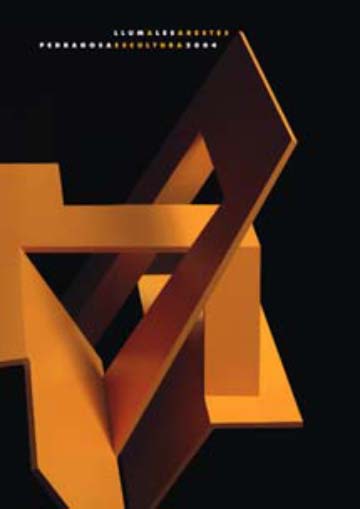

Joan Pedragosa or when art is simple presence
Maria Lluïsa Borràs
A happy reencounter with Joan Pedragosa, years later, when the prospects of a brilliant future in the plastic arts have largely been fulfilled. He had a background in geometry and so mastered geometric form and his painting and sculpture works do not express, symbolise or represent anything. They are pure plastic objects: simple presence.
He was the geometry artist when I knew him at the publishers, when he was involved in graphic design work as one of the great Catalan professionals of his generation. Now we meet again and he is now a mature plastic artist, with total control of expressive media, a master of space and volume, of form, matter and energy, and a master of rhythm, harmony and metaphysical condition. He is an admirable painter, a prodigious sculptor and has produced a considerable volume of work, which has arisen from twenty years of total, exclusive devotion.
Cosmological speculation, scientific discoveries and theories of the universe in the 20th century raised doubts about representation. Astronomic phenomena and the microscopic world can be represented by traditional methods, but the theory or relativity made the distance between a work of art and the reality it represents problematic.
The first artist to transgress the traditional way of investigating reality, Mondrian, carried out an extensive transformation of perception in his work. Starting from the deconstruction of form, he succeeded in changing painting into a force field and even managed to resolve the complexity of the opposing movement of different-length horizontal and vertical planes, by inventing a universal dialectic between positive and negative forces.
In ten years time, a century will have gone by since an unprecedented plastic revolution took place. This revolution was not simply a question of formal innovation, radical to a greater or lesser extent, but rather questioned the mimesis of reality, hitherto the grounds for art itself, and established the idea of the work of art as an independent object, formulated in geometric vocabulary. It was at the time of Mondrian and Malevich when the De Stijl review quoted Saint Augustine stating “Number in art is everything”. This seed was to bear fruit in the Bauhaus movement and awoke the fury of Nazism that declared it to be “degenerate art”. The Cercle et Carré and Art Concret movements in France rallied against such an aberrant view with the following declaration of principles:
“Concrete and not abstract art as there is nothing more concrete and more real than a line, a colour or a surface... Art is a means of giving optical form to a thought”.
A parallel phenomenon can be found in some of Brancusi’s sculptures, the ovoid objects of which are “models of the universe” in which he seems to meditate on pure form, while relating cosmic space to infinity and to an intimate and primary perception of form.
The proposal for deep change in how a work of art was conceived was later resumed by Lucio Fontana in 1955 when he stated “as a painter... I do not want to make a painting; I want to open up space, create a new dimension for art, and tie in with the cosmos as it endlessly expands beyond the confining plane of the picture”.
One of the noteworthy legacies of that revolution, albeit not very well known, is Madi art. This developed from the ideas of Torres Garcia who, on returning to Uruguay, played an important role as master and mentor. It is mentioned here because, throughout the years, styles and periods, some of Joan Pedragosa’s geometrical compositions strangely evoke the Madi world, which still persists among artists scattered around the world, who rise up against “awful romanticism, against the poets of small intimate drama, against the art of the élite and in favour of collective art”. Pedragosa’s concern for space and for time are therefore identified with his own research into abstract art and the relationship between abstract concept and form implies a structure that transmits the influence of perimeter on a greater scale and size.
In his interpretation of volume and space the artist points to a synthesis of constructivism and neo-plasticism, and of kinetic and minimalist art in virtuoso assemblies of geometric planes, of shapes suspended in space, the inflection point of which, midway between interior and exterior, shows a concern for structure.
By following the path taken by Moholy-Nagy and Calder, Pedragosa establishes a dialectic game between volume and emptiness and makes sculptures mobile in space. The volumes, planes and colours play in the space as if to illustrate the ideas of Mallarmé and Marinetti. These games and words are free.
Pedragosa occasionally surprises us with a playful element. Richter, in reference to Marcel Duchamp, said “homo sapiens were never wise, why not give homo ludens a chance? From the punched cardboard (Kartolinos) that provided a presentiment of the sculptures to come, and the aerial agility of the glass fibre rod mobiles up to the rotary, the importance of items of play, meaning real, pure play as one of the stays of civilisation, is clear. It is worth remembering that Johan Huizinga said that in order truly to play, man needs to feel like a child.